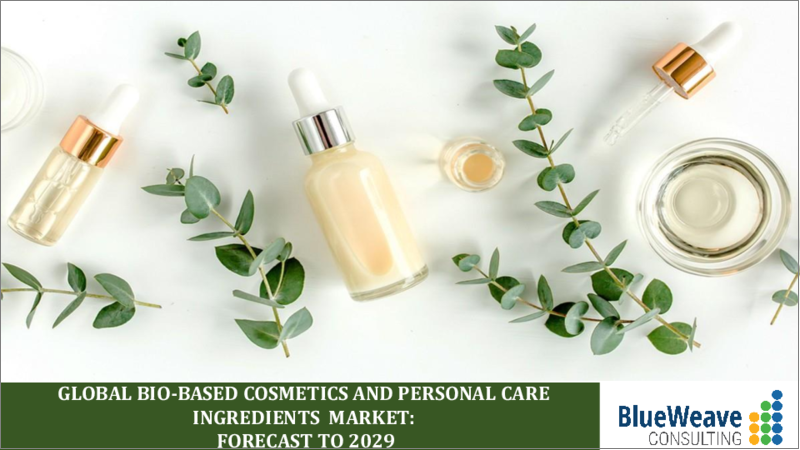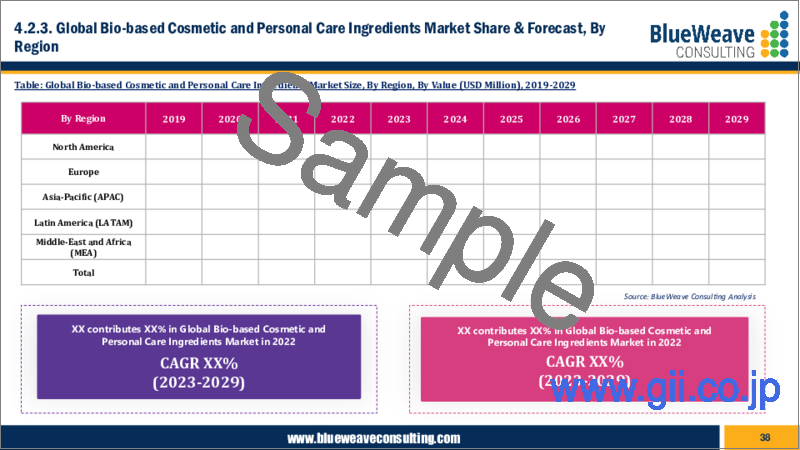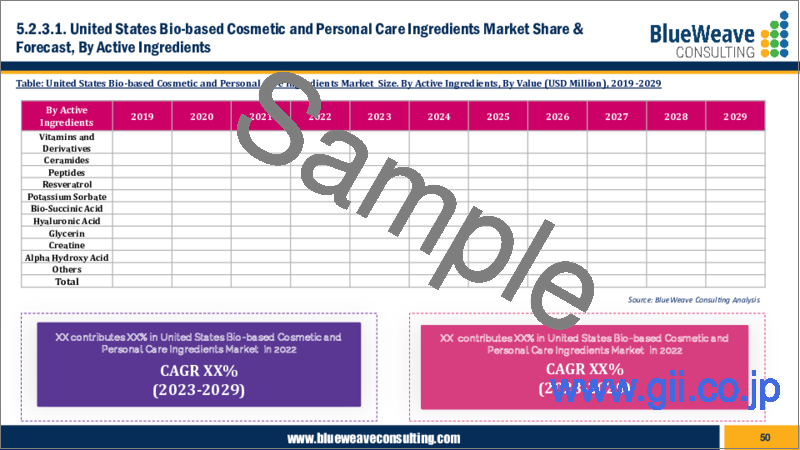|
|
市場調査レポート
商品コード
1274830
バイオベースコスメティクス&パーソナルケア成分の世界市場 (2019-2029年):有効成分・用途・地域別の市場規模・シェア・動向分析・機会・予測Bio-based Cosmetics and Personal Care Ingredients Market - Global Size, Share, Trend Analysis, Opportunity and Forecast Report, 2019-2029, Segmented By Active Ingredients ; By Application ; By Region |
||||||
| バイオベースコスメティクス&パーソナルケア成分の世界市場 (2019-2029年):有効成分・用途・地域別の市場規模・シェア・動向分析・機会・予測 |
|
出版日: 2023年05月09日
発行: Blueweave Consulting
ページ情報: 英文 400 Pages
納期: 2~3営業日
|
- 全表示
- 概要
- 目次
世界のバイオベースコスメティクス&パーソナルケア成分の市場規模は、2022年の48億8,755万米ドルから、予測期間中は4.48%のCAGRで推移し、2029年には70億4,825万米ドルの規模に成長すると予測されています。
市場の主な成長要因としては、天然素材や持続可能な製品に対する需要の高まり、産業オートメーションの拡大、産業顧客による投資能力、化粧品やパーソナルケア製品に使用される合成化学物質の有害性に対する意識の高まりなどが挙げられます。消費者は、自分たちの選択が環境に与える影響についてより強く意識するようになり、自然で持続可能な製品を求めるようになっています。
当レポートでは、世界のバイオベースコスメティクス&パーソナルケア成分の市場を調査し、市場概要、市場成長への各種影響因子の分析、技術動向、法規制環境、市場規模の推移・予測、各種区分・地域/主要国別の内訳、競合環境、主要企業のプロファイルなどをまとめています。
目次
第1章 調査の枠組み
第2章 エグゼクティブサマリー
第3章 世界のバイオベースコスメティクス&パーソナルケア成分市場に関する洞察
- 産業バリューチェーン分析
- DROC分析
- 促進要因
- 抑制要因
- 機会
- 課題
- 技術の進歩/最近の開発
- 規制の枠組み
- ポーターのファイブフォース分析
第4章 世界のバイオベースコスメティクス&パーソナルケア成分市場:概要
- 市場規模・予測
- 市場シェア・予測
- 有効成分別
- ビタミン・誘導体
- セラミド
- ペプチド
- レスベラトロール
- ソルビン酸カリウム
- バイオコハク酸
- ヒアルロン酸
- グリセリン
- クレアチン
- アルファヒドロキシ酸
- その他
- 用途別
- スキンケア・サンケア
- ヘアケア
- メイクアップ
- カラーコスメ
- フレグランス
- その他
- 地域別
- 北米
- 欧州
- アジア太平洋
- ラテンアメリカ
- 中東・アフリカ
第5章 北米のバイオベースコスメティクス&パーソナルケア成分市場
- 市場規模・予測
- 市場シェア・予測
- 有効成分別
- 用途別
- 国別
第6章 欧州のバイオベースコスメティクス&パーソナルケア成分市場
- 市場規模・予測
- 市場シェア・予測
- 有効成分別
- 用途別
- 国別
第7章 アジア太平洋のバイオベースコスメティクス&パーソナルケア成分市場
- 市場規模・予測
- 市場シェア・予測
- 有効成分別
- 用途別
- 国別
第8章 ラテンアメリカのバイオベースコスメティクス&パーソナルケア成分市場
- 市場規模・予測
- 市場シェア・予測
- 有効成分別
- 用途別
- 国別
第9章 中東・アフリカのバイオベースコスメティクス&パーソナルケア成分市場
- 市場規模・予測
- 市場シェア・予測
- 有効成分別
- 用途別
- 国別
第10章 競合情勢
- 主要企業・製品リスト
- 市場シェア分析
- 競合ベンチマーキング:経営パラメーター別
- 主要な戦略的展開 (M&A・提携など)
第11章 世界のバイオベースコスメティクス&パーソナルケア成分市場に対するCOVID-19の影響
第12章 企業プロファイル (企業概要・財務マトリックス・競合情勢・主要人材・主な競合相手・連絡先・戦略的展望・SWOT分析)
- BASF SE
- Clariant International Ltd.
- Croda International Plc
- Dow Inc.
- Eastman Chemical Company
- Evonik Industries AG
- Givaudan SA
- International Flavors & Fragrances Inc.
- Koninklijke DSM N.V.
- L'Oreal S.A.
- Lonza Group AG
- Royal DSM N.V.
- Symrise AG
- The Lubrizol Corporation
- Wacker Chemie AG
- その他の主要企業
第13章 主な戦略的提言
第14章 調査手法
Global Bio-based Cosmetics and Personal Care Ingredients Market Size Set to Cross USD 7 Billion by 2029.
Global bio-based cosmetics and personal care ingredients market is flourishing because of rising concerns about the environmental impact of chemical-based personal care products, increasing consumer awareness regarding the benefits of using bio-based products, and high disposable income and changing lifestyles of consumers.
BlueWeave Consulting, a leading strategic consulting and market research firm, in its recent study, estimated the global bio-based cosmetics and personal care ingredients market size at USD 4,887.55 million in 2022. During the forecast period between 2023 and 2029, BlueWeave expects the global bio-based cosmetics and personal care ingredients market size to grow at a steady CAGR of 4.48% reaching a value of USD 7,048.25 million by 2029. Major growth drivers for global bio-based cosmetics and personal care ingredients market include growing industrial automation and investment capacities of industrial customers in increasing demand for natural and sustainable products, as well as the increasing awareness about the harmful effects of synthetic chemicals used in cosmetics and personal care products. Consumers are becoming more conscious about the impact of their choices on the environment and are looking for natural and sustainable products. Bio-based cosmetics and personal care ingredients are derived from renewable resources and are considered more sustainable and environmentally friendly than their synthetic counterparts. The clean beauty movement emphasizes the use of natural, non-toxic, and eco-friendly products coupled with rising disposable income in emerging economies are driving demand for premium cosmetics and personal care products, including those made from bio-based ingredients.
Global Bio-Based Cosmetics and Personal Care Ingredients Market - Overview:
Bio-based cosmetics and personal care ingredients are ingredients that are derived from renewable resources, such as plants, algae, and microorganisms. These ingredients are considered more sustainable and environmentally friendly compared to their synthetic counterparts, as they have a lower environmental impact and are biodegradable. Bio-based ingredients offer a range of benefits for the skin and hair, such as hydration, anti-aging, and anti-inflammatory properties. They are used in a variety of personal care and cosmetic products, including skin care, hair care, makeup, and fragrances. Bio-based cosmetics and personal care ingredients are becoming increasingly popular due to the growing demand for natural and sustainable products, as well as the increasing awareness about the harmful effects of synthetic chemicals used in cosmetics and personal care products.
Impact of COVID-19 on Global Bio-Based Cosmetics and Personal Care Ingredients Market
COVID-19 pandemic had a dual impact on the global bio-based cosmetics and personal care ingredients market. While supply chain disruptions caused delays in the production and distribution of raw materials, leading to some shortages and increased prices, the pandemic also led to a shift in consumer preferences toward natural and sustainable products. It resulted in an increased demand for bio-based cosmetics and personal care ingredients, as consumers become more conscious of the impact of their choices on the environment and their health. Also, the pandemic highlighted the importance of clean beauty and personal hygiene, leading to an increased demand for bio-based ingredients in personal care and hygiene products.
Global Bio-Based Cosmetics and Personal Care Ingredients Market - By Application:
Based on application, global bio-based cosmetics and personal care ingredients market is divided into Skin & Sun Care, Hair Care, Make-up, Color Cosmetics, and Fragrances segments. The skin & sun care segment dominates the global bio-based cosmetics and personal care ingredients market, due to the increasing demand for natural and safe products. Bio-based ingredients used in skin and sun care products are considered safer and more sustainable alternatives to synthetic ingredients, appealing to consumers who are concerned about the impact of synthetic chemicals on their skin and health. Consumers are paying more attention to skin protection with increasing awareness of the harmful effects of UV radiation, and bio-based ingredients in sun care products, such as natural UV filters, offer effective sun protection while being safe and eco-friendly. Moreover, bio-based ingredients in skin & sun care products offer multiple benefits, such as moisturizing, anti-aging, and skin brightening effects, making them a popular choice among consumers.
Competitive Landscape:
Major players operating in global bio-based cosmetics and personal care ingredients market include: BASF SE, Clariant International Ltd., Croda International Plc, Dow Inc., Eastman Chemical Company, Evonik Industries AG, Givaudan SA, International Flavors & Fragrances Inc., Koninklijke DSM N.V., L'Oreal S.A., Lonza Group AG, Royal DSM N.V., Symrise AG, The Lubrizol Corporation, and Wacker Chemie AG. To further enhance their market share, these companies employ various strategies, including mergers and acquisitions, partnerships, joint ventures, license agreements, and new product launches.
The in-depth analysis of the report provides information about growth potential, upcoming trends, and statistics of Global Bio-Based Cosmetics and Personal Care Ingredients Market. It also highlights the factors driving forecasts of total market size. The report promises to provide recent technology trends in Global Bio-Based Cosmetics and Personal Care Ingredients Market and industry insights to help decision-makers make sound strategic decisions. Furthermore, the report also analyzes the growth drivers, challenges, and competitive dynamics of the market.
Table of Contents
1. Research Framework
- 1.1. Research Objective
- 1.2. Product Overview
- 1.3. Market Segmentation
2. Executive Summary
3. Global Bio-based Cosmetics and Personal Care Ingredients Market Insights
- 3.1. Industry Value Chain Analysis
- 3.2. DROC Analysis
- 3.2.1. Growth Drivers
- 3.2.1.1. Increasing consumer awareness regarding the benefits of using bio-based products
- 3.2.1.2. Rising concerns about the environmental impact of chemical-based personal care products
- 3.2.1.3. Rising disposable income and changing lifestyles of consumers
- 3.2.2. Restraints
- 3.2.2.1. Limited shelf life of bio-based products as compared to synthetic products
- 3.2.2.2. Difficulty in formulating bio-based products with consistent quality and effectiveness
- 3.2.3. Opportunities
- 3.2.3.1. Increasing investment in research and development of bio-based ingredients for personal care products
- 3.2.3.2. Increasing demand for multifunctional personal care products with added benefits
- 3.2.4. Challenges
- 3.2.4.1. Lack of awareness and understanding among consumers
- 3.2.1. Growth Drivers
- 3.3. Technology Advancements/Recent Developments
- 3.4. Regulatory Framework
- 3.5. Porter's Five Forces Analysis
- 3.5.1. Bargaining Power of Suppliers
- 3.5.2. Bargaining Power of Buyers
- 3.5.3. Threat of New Entrants
- 3.5.4. Threat of Substitutes
- 3.5.5. Intensity of Rivalry
4. Global Bio-based Cosmetics and Personal Care Ingredients Market Overview
- 4.1. Market Size & Forecast, 2019-2029
- 4.1.1. By Value (USD Million)
- 4.1.2. Market Share and Forecast
- 4.1.3. By Active Ingredients
- 4.1.3.1. Vitamins and Derivatives
- 4.1.3.2. Ceramides
- 4.1.3.3. Peptides
- 4.1.3.4. Resveratrol
- 4.1.3.5. Potassium Sorbate
- 4.1.3.6. Bio-Succinic Acid
- 4.1.3.7. Hyaluronic Acid
- 4.1.3.8. Glycerin
- 4.1.3.9. Creatine
- 4.1.3.10. Alpha Hydroxy Acids
- 4.1.3.11. Others
- 4.1.4. By Application
- 4.1.4.1. Skin and Sun Care
- 4.1.4.2. Hair Care
- 4.1.4.3. Make-up
- 4.1.4.4. Color Cosmetics
- 4.1.4.5. Fragrances
- 4.1.4.6. Others
- 4.1.5. By Region
- 4.1.5.1. North America
- 4.1.5.2. Europe
- 4.1.5.3. Asia Pacific (APAC)
- 4.1.5.4. Latin America (LATAM)
- 4.1.5.5. Middle East and Africa (MEA)
5. North America Bio-based Cosmetics and Personal Care Ingredients Market
- 5.1. Market Size & Forecast, 2019-2029
- 5.1.1. By Value (USD Million)
- 5.2. Market Share & Forecast
- 5.2.1. By Active Ingredients
- 5.2.2. By Application
- 5.2.3. By Country
- 5.2.3.1. United States
- 5.2.3.1.1. By Active Ingredients
- 5.2.3.1.2. By Application
- 5.2.3.2. Canada
- 5.2.3.2.1. By Active Ingredients
- 5.2.3.2.2. By Application
6. Europe Bio-based Cosmetics and Personal Care Ingredients Market
- 6.1. Market Size & Forecast, 2019-2029
- 6.1.1. By Value (USD Million)
- 6.2. Market Share & Forecast
- 6.2.1. By Active Ingredients
- 6.2.2. By Application
- 6.2.3. By Country
- 6.2.3.1. Germany
- 6.2.3.1.1. By Active Ingredients
- 6.2.3.1.2. By Application
- 6.2.3.2. United Kingdom
- 6.2.3.2.1. By Active Ingredients
- 6.2.3.2.2. By Application
- 6.2.3.3. Italy
- 6.2.3.3.1. By Active Ingredients
- 6.2.3.3.2. By Application
- 6.2.3.4. France
- 6.2.3.4.1. By Active Ingredients
- 6.2.3.4.2. By Application
- 6.2.3.5. Spain
- 6.2.3.5.1. By Active Ingredients
- 6.2.3.5.2. By Application
- 6.2.3.6. Belgium
- 6.2.3.6.1. By Active Ingredients
- 6.2.3.6.2. By Application
- 6.2.3.7. Russia
- 6.2.3.7.1. By Active Ingredients
- 6.2.3.7.2. By Application
- 6.2.3.8. The Netherlands
- 6.2.3.8.1. By Active Ingredients
- 6.2.3.8.2. By Application
- 6.2.3.9. Rest of Europe
- 6.2.3.9.1. By Active Ingredients
- 6.2.3.9.2. By Application
7. Asia-Pacific Bio-based Cosmetics and Personal Care Ingredients Market
- 7.1. Market Size & Forecast, 2019-2029
- 7.1.1. By Value (USD Million)
- 7.2. Market Share & Forecast
- 7.2.1. By Active Ingredients
- 7.2.2. By Application
- 7.2.3. By Country
- 7.2.3.1. China
- 7.2.3.1.1. By Active Ingredients
- 7.2.3.1.2. By Application
- 7.2.3.2. India
- 7.2.3.2.1. By Active Ingredients
- 7.2.3.2.2. By Application
- 7.2.3.3. Japan
- 7.2.3.3.1. By Active Ingredients
- 7.2.3.3.2. By Application
- 7.2.3.4. South Korea
- 7.2.3.4.1. By Active Ingredients
- 7.2.3.4.2. By Application
- 7.2.3.5. Australia & New Zealand
- 7.2.3.5.1. By Active Ingredients
- 7.2.3.5.2. By Application
- 7.2.3.6. Indonesia
- 7.2.3.6.1. By Active Ingredients
- 7.2.3.6.2. By Application
- 7.2.3.7. Malaysia
- 7.2.3.7.1. By Active Ingredients
- 7.2.3.7.2. By Application
- 7.2.3.8. Singapore
- 7.2.3.8.1. By Active Ingredients
- 7.2.3.8.2. By Application
- 7.2.3.9. Vietnam
- 7.2.3.9.1. By Active Ingredients
- 7.2.3.9.2. By Application
- 7.2.3.10. Rest of APAC
- 7.2.3.10.1. By Active Ingredients
- 7.2.3.10.2. By Application
8. Latin America Bio-based Cosmetics and Personal Care Ingredients Market
- 8.1. Market Size & Forecast, 2019-2029
- 8.1.1. By Value (USD Million)
- 8.2. Market Share & Forecast
- 8.2.1. By Active Ingredients
- 8.2.2. By Application
- 8.2.3. By Country
- 8.2.3.1. Brazil
- 8.2.3.1.1. By Active Ingredients
- 8.2.3.1.2. By Application
- 8.2.3.2. Mexico
- 8.2.3.2.1. By Active Ingredients
- 8.2.3.2.2. By Application
- 8.2.3.3. Argentina
- 8.2.3.3.1. By Active Ingredients
- 8.2.3.3.2. By Application
- 8.2.3.4. Peru
- 8.2.3.4.1. By Active Ingredients
- 8.2.3.4.2. By Application
- 8.2.3.5. Rest of LATAM
- 8.2.3.5.1. By Active Ingredients
- 8.2.3.5.2. By Application
9. Middle East & Africa Bio-based Cosmetics and Personal Care Ingredients Market
- 9.1. Market Size & Forecast, 2019-2029
- 9.1.1. By Value (USD Million)
- 9.2. Market Share & Forecast
- 9.2.1. By Active Ingredients
- 9.2.2. By Application
- 9.2.3. By Country
- 9.2.3.1. Saudi Arabia
- 9.2.3.1.1. By Active Ingredients
- 9.2.3.1.2. By Application
- 9.2.3.2. UAE
- 9.2.3.2.1. By Active Ingredients
- 9.2.3.2.2. By Application
- 9.2.3.3. Qatar
- 9.2.3.3.1. By Active Ingredients
- 9.2.3.3.2. By Application
- 9.2.3.4. Kuwait
- 9.2.3.4.1. By Active Ingredients
- 9.2.3.4.2. By Application
- 9.2.3.5. South Africa
- 9.2.3.5.1. By Active Ingredients
- 9.2.3.5.2. By Application
- 9.2.3.6. Nigeria
- 9.2.3.6.1. By Active Ingredients
- 9.2.3.6.2. By Application
- 9.2.3.7. Algeria
- 9.2.3.7.1. By Active Ingredients
- 9.2.3.7.2. By Application
- 9.2.3.8. Rest of MEA
- 9.2.3.8.1. By Active Ingredients
- 9.2.3.8.2. By Application
10. Competitive Landscape
- 10.1. List of Key Players and Their Offerings
- 10.2. Global Bio-based Cosmetics and Personal Care Ingredients Market Share Analysis, 2022
- 10.3. Competitive Benchmarking, By Operating Parameters
- 10.4. Key Strategic Developments (Mergers, Acquisitions, Partnerships, etc.)
11. Impact of Covid-19 on Global Bio-based Cosmetics and Personal Care Ingredients Market
12. Company Profile (Company Overview, Financial Matrix, Competitive Landscape, Key Personnel, Key Competitors, Contact Address, Strategic Outlook, SWOT Analysis)
- 12.1. BASF SE
- 12.2. Clariant International Ltd.
- 12.3. Croda International Plc
- 12.4. Dow Inc.
- 12.5. Eastman Chemical Company
- 12.6. Evonik Industries AG
- 12.7. Givaudan SA
- 12.8. International Flavors & Fragrances Inc.
- 12.9. Koninklijke DSM N.V.
- 12.10. L'Oreal S.A.
- 12.11. Lonza Group AG
- 12.12. Royal DSM N.V.
- 12.13. Symrise AG
- 12.14. The Lubrizol Corporation
- 12.15. Wacker Chemie AG
- 12.16. Other Prominent Players
13. Key Strategic Recommendations
14. Research Methodology
- 14.1. Qualitative Research
- 14.1.1. Primary & Secondary Research
- 14.2. Quantitative Research
- 14.3. Market Breakdown & Data Triangulation
- 14.3.1. Secondary Research
- 14.3.2. Primary Research
- 14.4. Breakdown of Primary Research Respondents, By Region
- 14.5. Assumptions & Limitations




